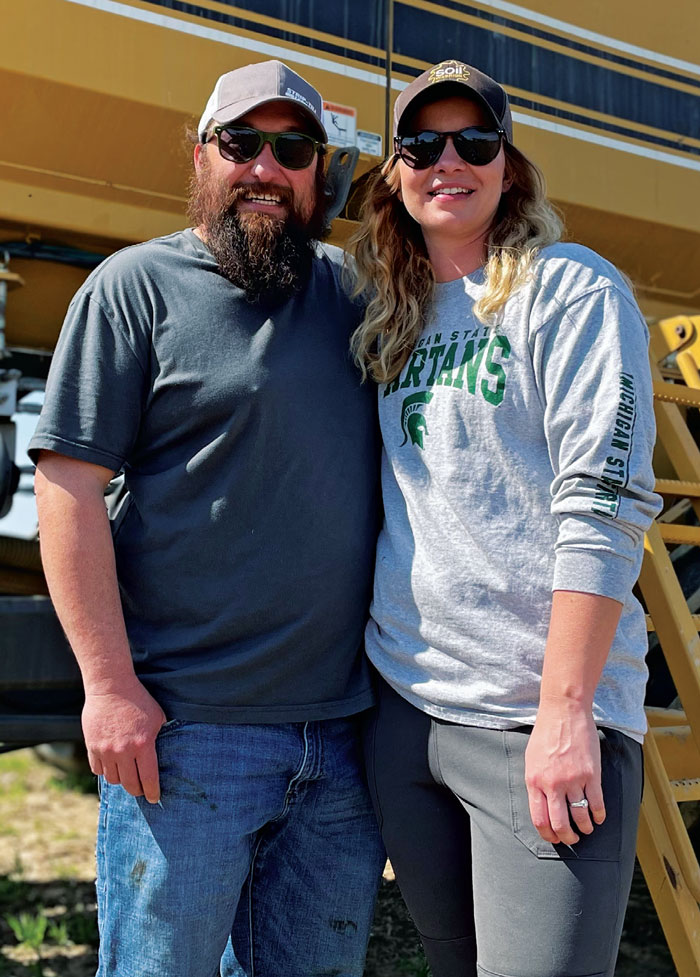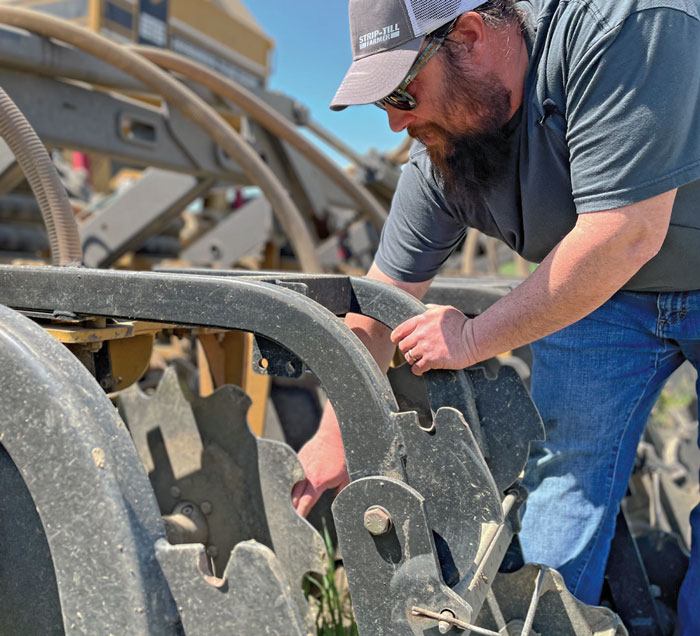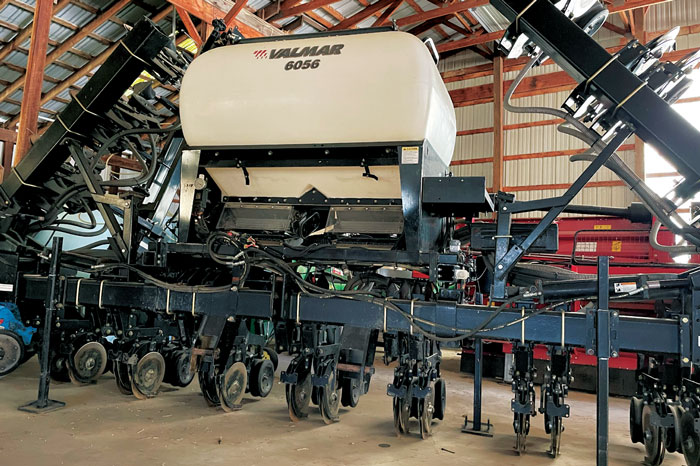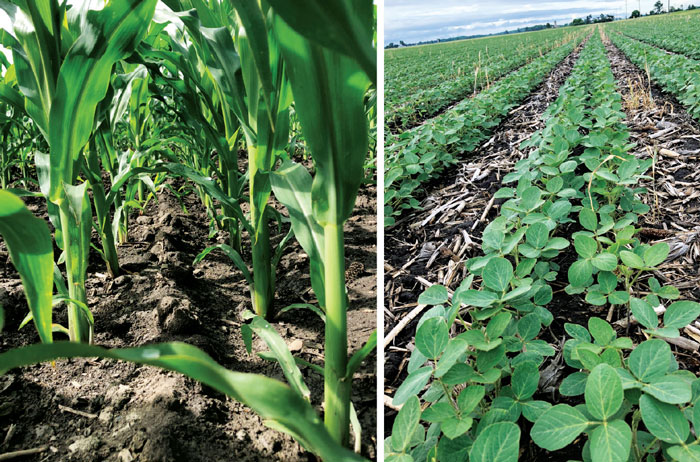Ryan and Melissa Shaw of Marlette, Mich., had their fair share of anxiety when going all in on strip-till in the fall of 2014. It was a major investment, and there was a sizable learning curve after a lifetime of conventional farming. Plus, there weren’t many strip-tillers in their area that they could turn to for advice. They soon found the answers to their most pressing questions in one place.
“We started going to the National Strip-Tillage Conference and couldn’t believe all the answers we could get at one event,” Melissa says.
“We picked up a lot of information at the conference from like-minded people who think that just because something’s different doesn’t mean it’s wrong,” Ryan says. “We keep coming back to try to get a little better every year.”
“That’s the most exciting part of farming — seeing our ideas come to life…”
The Shaws will make their ninth trip to the conference in August 2023. This one will be extra special as they’ll be presented with the 2023 Strip-Till Innovator Award for their significant contribution to the advancement of strip-till and commitment to soil health practices.
Conservation Legacy
The Shaws own and operate SKS Farm, along with their longtime neighbor Bruce Brock. Located in the “thumb” of Michigan, they grow corn, soybeans, sugar beets and cereal rye across 1,400 acres.
The farm was established by Ryan’s parents, Scott and Henrietta Shaw, in 2004. Scott instilled an innovative approach to farming in Ryan before handing him the keys to the operation. He always stressed the importance of leaving the ground “better than how we found it,” Ryan recalls. Scott passed away in February 2022, 8 years after being diagnosed with early onset Alzheimer’s.
“When he passed away it was for the better — growing up, he was never sick or in the hospital, so when his health started to decline, it was tough on him,” Ryan says. “Luckily, his memory of family and friends was never lost. Dad enjoyed at least 7 good years after the diagnosis. When I took over the farm, he said, ‘Now this is going to be your problem. It’s time I pay Mom back for all the years I had a farming habit.’ They went and enjoyed life. He was ecstatic that we were taking the next step with strip-till.”

Ryan and Melissa Shaw are the recipients of the 2023 Strip-Till Innovator Award, as voted on by an independent panel of judges. The Shaws went all in on strip-till and twin-row planting in 2014, and they are an open book when it comes to sharing their journey with other farmers Photo by: Noah Newman
Scott’s legacy lives on through Ryan and Melissa, who prioritize soil health and sharing their knowledge with others. They were original members of the Thumb Area Farmer-Led Watershed Group, a network of farmers focused on navigating conservation practices.
“We enjoy learning from other people and their experiences,” Ryan says. “Strip-till has generated a lot of excitement and made farming even more fun for us. I learned from Dad that if you’re going to do something for a living, it better be fun. He always said, ‘We’re going to farm, and we’re going to have fun doing it. If we don’t, then we better find something else to do.’”
The Nature Conservancy honored Ryan and Melissa with the Conservation Innovation Award in 2019. They’ve hosted numerous field days over the years, including the Strip-Tillage Demo Day with the Blue Water Conservation District in 2017 and the Michigan 4R Field Day in 2021.
“We’re usually attending every meeting that’s close by and trying to be a part of everything if we can,” Melissa says.
“We’re an open-door farm, always excited to show people what we’re trying,” Ryan adds.
Doubling Down
The Shaws bought an Environmental Tillage Systems (ETS) SoilWarrior and made their first strips in the fall of 2014. All eyes were on them to see if it would work — or at least that’s what it felt like in an area where strip-till was mostly a foreign concept.
“That first year was a nerve-wrecking experience because you always have that fear of failure, and all of our neighbors were watching,” Ryan says. “I just remember thinking, ‘Please don’t let us fall on our face.’”
“Residue management was the biggest challenge,” Melissa says. “It was mostly trial and error — figuring out what worked and what didn’t those first few years.”

The Shaw’s Environmental Tillage Systems (ETS) SoilWarrior has a widening kit to create a big enough berm for twin-row planting. When one of the SoilWarrior’s 2 tanks isn’t being used for fertilizer application, they’ll fill it with cover crops to apply in the fall. “We’ll blow oats and buckwheat into the berm to help hold it together,” Ryan says. Photo By: Noah Newman
The transition was made even more challenging by their decision to implement a twin-row system. But despite some early growing pains, twin-row strip-till quickly paid off in the form of fewer field passes, lower fuel costs and an average yield bump of 15 bushels per acre.
The Shaws plant corn in 30-inch twin rows with 8-inch spacing, which allows them to increase the seeding rate to 38,000. It’s one of many benefits that comes with twin-row planting.
“Land is quite expensive in our area, so we figured why not use more of what we already have,” Ryan says. “With 30-inch single rows, we were only using around 14.5% of each acre. With twin rows, we’re now using about 45% of each acre, which allows us to plant higher populations without having to spend money on extra acres.”
“I remember thinking, ‘Please don’t let us fall on our face’…”
They calculate that 30-inch single rows only use 30% of available sunlight, while 20-inch single rows use 68% and 30-inch twin rows use 90% of available sunlight.
“Sunlight is free, so why not try to capture more of it?” Ryan says. “The plants utilize more available sunlight in twin rows. With a quicker canopy, we’re also seeing improved water retention and less weed pressure.”
The Shaws also plant soybeans in twin rows at a seeding rate of 120,000. But it’s a different story for sugar beets, which are planted in single rows at a rate of 54,000-60,000 in the seed bed between the twin-row corn root balls.
“It took a few years for us to be brave enough to plant sugar beets that way,” Ryan says. “We only tried it on 30 acres the first few years to make sure it would work. Each year we find something to tweak. Ultimately Mother Nature wins, so we’re always adjusting.”
‘Slightly Intimidating’ Machine
The Shaws were initially drawn to strip-till because of its 2-for-1 ability to apply fertilizer and prepare the seedbed in a single pass. They variable rate apply phosphorous (P) and potassium (K) using a twin commodity tank on their 12-row SoilWarrior, while building strips 5-7 inches deep in the fall. They’ll sometimes freshen strips 3-4 inches deep in the spring before planting.
“We’re running two 8-wave directional coulters in the back and a 13-wave lead coulter kit,” Ryan says. “It has a widening kit, which allows us to build big enough strips to plant twin-rows. The widening kit makes the hubs on the coulters 8 inches apart, which is the same exact spacing on my two seed discs on the planter — we can actually feel it line up when we drop the planter in.”

The Shaws built an interseeder to plant their cover crops in the “never-till” zones outside of the twin rows. They also use it to interseed a mix of up to 8 species in corn around V3-V5. “We’re not interseeding cover crops to bump a yield or feed the corn, but rather to get something started by fall and cover the ground over winter,” Ryan says. Photo By: Noah Newman
The Shaws added rolling baskets because the confinement wheels were getting too aggressive when they first started strip-tilling. The wheels left a ridge along the edge that water would follow, but the rolling baskets eliminated that problem.
They also installed a camera between the row units on the SoilWarrior, so they can monitor from the cab if they’re blowing out the row or moving trash too far when making strips.
RTK guidance technology and the SoilWarrior’s steerable cart help achieve precise nutrient placement. The Shaws optimize fertilizer use even further by planting in the same zone every year, leaving a nutrient-rich band for future crops.
“The plants are able to utilize more available sunlight in twin rows…”
“Our strip-till rig is a slightly intimidating machine at first glance, but the idea behind what it’s doing is simple,” Ryan says. “We haven’t had many issues with it in terms of having to swap or change anything. We don’t get too aggressive with the row cleaners and just let the coulters do most of the work.”
The Dream Team
Melissa, Ryan and Bruce each have their own unique responsibilities on the farm. Ryan runs the SoilWarrior, Bruce operates the planter, and Melissa takes care of nutrient management prescriptions and the books.
“We work well together, and we’ve been together long enough that we know what to expect of each other and what needs to get done,” Melissa says.
“Melissa pulls all our soil samples from inside and outside our planting zones, and makes our nutrient management prescriptions based on those,” Ryan says. “She also oversees pest management, scouting and runs the dryer during harvest as well. She’s the most patient among us and always keeps us honest.
“Bruce is like a shop manager,” Ryan adds. “He tells us what the planter needs. He also does band spraying, sidedressing and runs the grain cart during harvest. He’s getting close to retirement. It will probably take 3 people to fill his position when he’s gone.”
Bruce covers all acres with their 30-foot, 12-row Monosem stack-fold twin-row planter — a do-it-all machine that takes care of soybean, corn and sugar beet planting. The Shaws added a hitch to the back of the planter to pull a Yetter steerable wagon, which contains a 1,600-gallon tank for fertilizer. When the steerable wagon isn’t attached, Bruce pulls an ETS RollerWarrior behind the planter to smooth and firm the seedbed while planting soybeans.
Nitrogen (N) is split-applied for corn — 65 pounds per acre with Thio-Sul and liquid K in a 2-by-2 placement at planting, followed by the remainder of N, along with Thio-Sul and liquid K, sidedressed with Y-drops around V5. Total N applied to corn ranges from 180-205 pounds depending on soil type and productivity. 6.5 gallons of a low-salt in-furrow popup fertilizer mix of macro- and micronutrients (including zinc, sulfur, iron, manganese, copper, cobalt, and molybdenum) and a biological is also applied at planting.
2023 Strip-Till Innovator Video Series
Click here for an inside look at Ryan and Melissa Shaw’s strip-till operation in the 7-part Strip-Till Innovator Video Series. The Shaws detail the ups and downs of their transition to strip-till, keys to success, SoilWarrior setup and showcase their homemade interseeder. The Strip-Till Farmer Strip-Till Innovator video series is brought to you by Montag Mfg.
Sugar beets receive a similar treatment — an in-furrow blend of NPK, micronutrients, and a biological at a rate of 4 gallons per acre; a 2-by-2 application with N, Thio-Sul and liquid K; and a balance of N and Thio-Sul applied at sidedress when sugar beets are at the 6-10 leaf stage. Total N for sugar beets is usually in the range of 140-150 pounds per acre, also dependent upon soil type and productivity of a particular field.
Soybeans receive an in-furrow blend of micronutrients and a biological at planting time using a tank mounted atop the RollerWarrior.
The Shaws work with Ag Spectrum, employing the company’s Maximum Farming System to better manage their crops and soils. After sampling, recommendations are made to manage calcium and magnesium levels using various liming products, as well as gypsum, to achieve ideal pH and porosity. From there, variable rate P and K recommendations and prescriptions are made to any zones that drop below optimal base saturation levels.
Melissa takes soil samples based on soil type and management zones, paying close attention to P availability timing, organic matter, K, magnesium, calcium and pH levels. The heavy workload keeps the dream team busy most days, but they’re able to accomplish their goals while maintaining a healthy work-life balance.
“I think about how Dad worked so hard his whole life and barely got to enjoy retirement,” Ryan says. “There’s no reason we can’t enjoy life with the way we’re farming now. We’ll call it an early day sometimes if what we’re doing isn’t time sensitive. Family matters. If Bruce needs to leave to go to his grandkid’s baseball game, that kind of stuff needs to happen. We work hard but we like to play hard, too.”
Reviving the Soil
Ryan was asked a tough question by another farmer at the 2022 National Strip-Tillage Conference: Hypothetically, if you were forced to get rid of strip-till or cover crops, which would you get rid of?
“For me, I guess it would all depend on the field, the acreage or the farm that I was dealing with at that time,” Ryan says. “If I wasn’t applying any nutrients or banding it down, I’d keep the cover crop.”
It was a hard question for Ryan to answer because cover crops are a crucial piece to their strip-till puzzle.
“If you’re going to plant cover crops, that’s a great choice, but there has to be a reason why, not just to be part of a trend,” Ryan says. “The biggest reasons for us are weed suppression and erosion control. The key with cover crops is you need to take the time to plan ahead, identify your growing window, figure out your budget and determine what species you can actually use.”
Cover crops choke out weeds in their planting zones and reduce herbicide costs. They also keep the soils covered during harsh Michigan winters and protect sugar beets from high winds.
“After 5 years, the soil started changing…”
“Letting the rye grow actually enabled it to act like a windbreaker for our plant zones,” Ryan says. “When the sugar beets are tiny, they’re susceptible to sand and soil particles shredding them during our windy springs. We’ll wait until the beets are 6-8 leaves big now before killing off the rye with the first herbicide spray.”
But their cover cropping journey has come with a few bumps. Ryan and Melissa had to overcome some early challenges before they could start cashing in on the benefits.
“We were planting cereal rye with a 20-foot no-till drill after soybean harvest,” Ryan says, “but then a month later when building our fall strips, we were ripping out two perfect rows. Also, one spring, we had trouble closing our slot because there was a mess of roots caused by overseeded cereal rye in the planting zone.”
The Shaws decided they could cut costs in half and avoid problems in the strips by planting cereal rye outside of the planting zones with their homemade interseeder.

The Shaws plant corn (L) and soybeans (R) in 30-inch twin rows with 8-inch spacing. Cereal rye is seeded outside of the rows in the “never-till” zone. The twin rows allow the Shaws to use up to 45% of each acre, as compared to only 14.5% with single rows. With a boost from “amazing rainfall,” corn yields increased from 195 bushels per acre to 235 bushels per acre in the first year of their twin-row strip-till system. Photo By: Ryan Shaw
“We stripped down a Hiniker cultivator to just the bar and attached Dawn DuoSeed row units and a Valmar/Salford metering tank, which we purchased from a guy we met at the National Strip-Tillage Conference,” Melissa says. “We use it to interseed corn around V3-V5 with a mix of annual ryegrass, hairy vetch, cowpeas, radishes, and buckwheat. We use the interseeder — as we call it — to now plant all of our cover crops. It’s a versatile tool — we’ve even used it like an air boom to apply Epsom salts to areas that are low in magnesium. I’m always amazed when we come up with something like this and it works because I’ve never had a background in farming or engineering. That’s one of the most interesting parts of farming to me — seeing our grand ideas come to fruition.”
They’ll also use a spare tank on their SoilWarrior to apply buckwheat and oats into their fall strips, which terminate over winter and help keep the strip together.
Cover crops, along with twin-row planting and strip-till, are leaving the ground in better shape than how they found it, just as Ryan’s dad wanted.
“Dad got to see some of the learning curve and early struggles we experienced when switching to strip-till,” Ryan says. “It’s just too bad he didn’t get to see the rewarding part. After about 5 years, the soil started changing. It was like we revived it — we woke it back up, and now it’s starting to pay us back for how we’re treating it.”







Post a comment
Report Abusive Comment